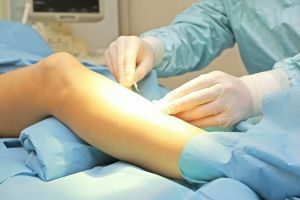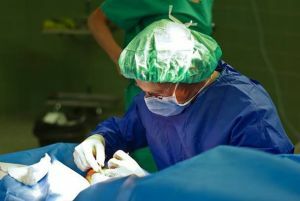 Microflebectomy is an operation to remove pathologically altered subcutaneous veins. The operation is minimally invasive( ie performed with minimal damage to the skin), does not require general anesthesia and has a high cosmetic effect.
Microflebectomy is an operation to remove pathologically altered subcutaneous veins. The operation is minimally invasive( ie performed with minimal damage to the skin), does not require general anesthesia and has a high cosmetic effect.
Microflebectomy can be used both as an independent procedure and as a stage of complex treatment of varicose veins.
During the intervention, only the subcutaneous veins affected by varicose veins are removed. All subcutaneous veins in the human body account for only 10% of the blood flow, so removing one or more pathologically altered veins can not adversely affect blood circulation and entail atrophy of tissues.
But such intervention relieves patients of unpleasant sensations and restores aesthetically attractive appearance to the legs, which positively affects the patient's self-esteem.
Contents
- Indications and contraindications to the procedure
- What is the difference from other methods?
- Preparatory stage
- How is the operation performed?
- Recovery phase
- How much will treatment cost?
Indications and contraindications to the procedure
The main indication for conducting microflebectomy is the presence of varicose veins with a diameter of more than 10 mm. 
In addition, this method is used to eliminate large varicose nodules, treat violations of outflow of blood in the legs, correct the consequences of the transferred acute form of thrombophlebitis and as an auxiliary method after other surgical manipulations with the veins.
Microflebectomy is able to combat varicose trophic ulcers, bleeding and violation of venous outflow.
Contraindications to the operation are infectious diseases, violation of the integrity of the skin at the site of the operation( inflammation, wounds), diseases of the cardiovascular and pulmonary systems, as well as pregnancy.
What is the difference from other methods?
 Microflebectomy( miniflebectomy) refers to the radical methods of treatment of pathologically altered veins. This means that, unlike other, non-radical methods of intervention, a remote vein will never bother the patient again. A feature is the minimally invasive method.
Microflebectomy( miniflebectomy) refers to the radical methods of treatment of pathologically altered veins. This means that, unlike other, non-radical methods of intervention, a remote vein will never bother the patient again. A feature is the minimally invasive method.
Surgical operations of the previous generation provided for cuts during the operation, which increased both morbidity and the risk of complications in the patient. The method of removing veins with punctures does not have these drawbacks while maintaining the same efficiency.
The benefits of microflebectomy over other methods include, first of all, high cosmetic effect and reliability of the method. Other distinguishing features include low traumatism, and as a result - a low incidence of complications, no need for deep anesthesia, outpatient treatment of the patient.
Also a plus is a very short recovery period - literally a couple of days later the patient can return to his habitual way of life.
Preparatory stage
Preparation for the operation includes a visit to the doctor and ultrasound examination of the veins. After the doctor decides on the need for surgery, the patient gives general tests of urine and blood and passes the ECG procedure.
The following is an anamnesis: the patient should tell the doctor what medications he is taking and if he is allergic to any medications. Immediately before operations from the patient, no special training is required.
How is the operation performed?
The operation is performed as follows:
- the doctor marks the places of future punctures with a marker - these are the places where varicose veins are located;
- skin in marked places pierce. The diameter of each puncture is no more than 1-2 mm;
- inserts a surgical hook into the puncture, they are hooked up to the vein and outward through the same hole;
- vein is fixed with clamps, intersected and removed;
- next to the first puncture do another, through which the rest of the vein is likewise removed.

After the operation, no suturing is required - a linear patch and compression knitwear are applied to the puncture sites.
The patient is not required to be hospitalized - almost immediately after the operation he can go home. Workability is restored after 1-2 days.
After surgery, the patient does not experience pain, the only consequence is a small bruise at the site of the surgery, or a pigmented spot on the skin. These traces disappear after a few weeks after the operation, and the traces of the punctures completely disappear after a couple of months.
Recovery stage
Rehabilitation after a previous operation of microflebectomy suggests measures for normalization of venous outflow: massage, water  procedures, therapeutic gymnastics.
procedures, therapeutic gymnastics.
The patient can walk the next day after the operation, making ten-minute breaks and positioning the leg in a raised state. After about a week, he can start physiological procedures, do gymnastic exercises with an emphasis on the sick limb.
For a month and a half or two months, it is necessary to wear compression knitwear and take medications prescribed at discharge - they tonify the veins and improve blood circulation.
Despite the fact that complications after microflebectomy are rare, they still occur. This is mainly due to a patient's violation of the doctor's recommendations( refusal to wear bandages, drugs, physical exertion) or because of the progression of venous disease.
Complications can be manifested as:
- loss or decreased sensitivity of the skin at the site of surgery;
- suppuration;
- bleeding;
- for the formation of new venous extensions immediately near the site of intervention or in another part of the leg;
- pain in place of scars.
To avoid these consequences will help responsible attitude to their health, the implementation of all necessary procedures and supervision of the attending physician.
How much will treatment cost?
In the capital's clinics in Russia, the price of an operation for microflebectomy will cost from 10 to 30 thousand rubles. The price of the operation depends on the area of the enlarged veins( local expansion or finiteness entirely), the degree of neglect, the type of veins( deep or superficial subcutaneous).
 In addition, you have to shell out for a phlebologist consultation( a specialist in venous surgery) and preliminary tests before the operation.
In addition, you have to shell out for a phlebologist consultation( a specialist in venous surgery) and preliminary tests before the operation.
Consultation with a physician-phlebologist will allow to evaluate the actual need for the procedure depending on the severity of the disease and the patient's condition.
The main risk group for which surgery is not performed or is carried out with great care are people suffering from hypertension, diabetes, cardiovascular diseases. Separate attention deserves elderly patients and women in late pregnancy.
In case of advanced stages of varicose veins, the patient may need a combined sapectomy. This is due to the fact that in the late stages of the disease the vein loses its direct course and becomes convoluted, which complicates its removal.
In such cases, before making a decision about the need for surgery, the vein is carefully examined by ultrasound techniques. Combination of the technique is that the vein of the vein is removed by means of notches - i.e.the usual phlebectomy, and varicose inflows( branches) are eliminated with the help of microflebectomy.
